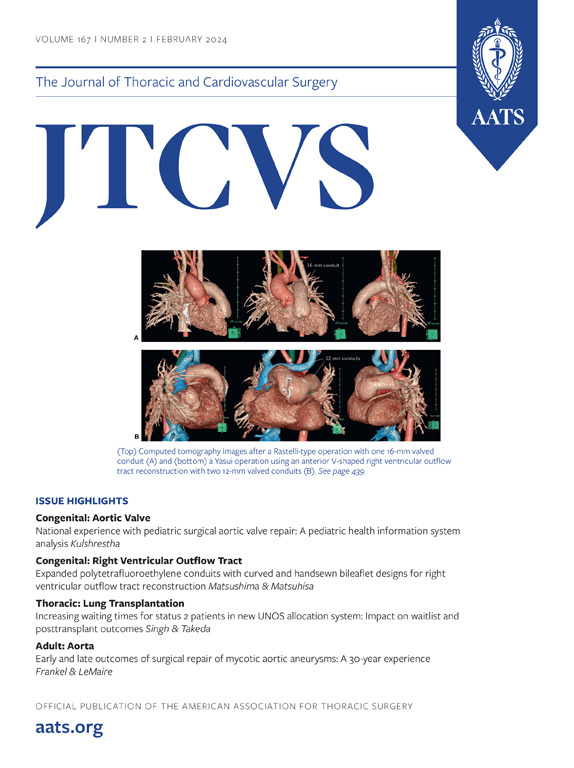血型和体型对使用主动脉内球囊反搏泵或手术植入微轴左心室辅助装置成功完成心脏移植的影响
IF 4.4
1区 医学
Q1 CARDIAC & CARDIOVASCULAR SYSTEMS
Journal of Thoracic and Cardiovascular Surgery
Pub Date : 2024-09-25
DOI:10.1016/j.jtcvs.2024.09.028
引用次数: 0
摘要
目的:UNOS 状态 2 心脏移植(HTx)候选者的候诊时间稳步增加。我们比较了在 O 型血患者中使用 Impella 5.0/5.5 ("Impella")或主动脉内气囊泵 (IABP) 与耐用 LVAD 的桥接策略,并根据体型进行了分层:方法: 在 UNOS 注册表中查询了由 Impella、IABP 或 HM3 LVAD 支持的去原发性 HTx(无透析)的成人。主要结果是列入名单后一年的存活率,定义为候选名单时间和接受 HTx 后存活时间(如果候选者接受了 HTx)之和:共纳入 2,942 名候选人(Impella:214 人;IABP:1326 人;HM3:1402 人)。与 HM3 LVAD 相比,Impella 或 IABP 与 O 型血患者上市后存活率较低有关(Impella:HR 2.90 [95% CI 1.48-5.67],P=0.002;IABP:HR 2.42 [95% CI 1.59-3.68],P=0.002):在当前器官分配时代,与耐用型 LVAD 相比,使用 Impella 或 IABP 的 O 型血候选者上市后的死亡风险更高。身高和体型正常的患者受到的影响较小。本文章由计算机程序翻译,如有差异,请以英文原文为准。
The impact of blood type and body size on successful bridging to heart transplantation using intra-aortic balloon pump or surgically implanted microaxial left ventricular assist device
Objective
Waitlist time for United Network for Organ Sharing Status 2 heart transplant candidates has steadily increased. We compared a bridging strategy using either the Impella 5.0/5.5 (“Impella”) or intra-aortic balloon pump with a durable left ventricular assist device in patients with blood type O stratified by body habitus.
Methods
The United Network for Organ Sharing registry was queried for adults listed for de novo heart transplantation (without dialysis) supported by the Impella, an intra-aortic balloon pump, or the HeartMate 3 left ventricular assist device. The primary outcome was 1-year postlisting survival, defined as the sum of waitlist time and post–heart transplant survival time if the candidate underwent heart transplantation.
Results
In total, 2942 candidates were included (Impella: 214; intra-aortic balloon pump: 1326; HeartMate 3: 1402). Listing with the Impella or intra-aortic balloon pump was associated with worse postlisting survival compared with the HeartMate 3 left ventricular assist device in type O candidates (Impella: hazard ratio, 2.90 [95% CI, 1.48-5.67], P = .002; intra-aortic balloon pump: hazard ratio, 2.42 [95% CI, 1.59-3.68], P < .001) but less so in non–type O candidates. Further analysis of type O candidates demonstrated that the Impella and intra-aortic balloon pump were associated with a lower risk of postlisting mortality among those with normal height (25-75th percentile) and nonobese (body mass index <30) (Impella: hazard ratio, 1.78 [95% CI, 0.61-5.18], P = .292; intra-aortic balloon pump: hazard ratio, 1.28 [95% CI, 0.67-2.45], P = .455); among those not of normal height and nonobese, the Impella and intra-aortic balloon pump were associated with an elevated risk of postlisting mortality (Impella: hazard ratio, 3.65 [95% CI, 1.68-7.95], P = .001; intra-aortic balloon pump: hazard ratio, 3.01 [95% CI, 1.95-4.67], P < .001).
Conclusions
Blood type O candidates listed with the Impella or intra-aortic balloon pump are at increased risk of postlisting mortality compared with a durable left ventricular assist device in the current organ allocation era. These effects are diminished among those with normal height and body habitus.
求助全文
通过发布文献求助,成功后即可免费获取论文全文。
去求助
来源期刊
CiteScore
11.20
自引率
10.00%
发文量
1079
审稿时长
68 days
期刊介绍:
The Journal of Thoracic and Cardiovascular Surgery presents original, peer-reviewed articles on diseases of the heart, great vessels, lungs and thorax with emphasis on surgical interventions. An official publication of The American Association for Thoracic Surgery and The Western Thoracic Surgical Association, the Journal focuses on techniques and developments in acquired cardiac surgery, congenital cardiac repair, thoracic procedures, heart and lung transplantation, mechanical circulatory support and other procedures.

 求助内容:
求助内容: 应助结果提醒方式:
应助结果提醒方式:


